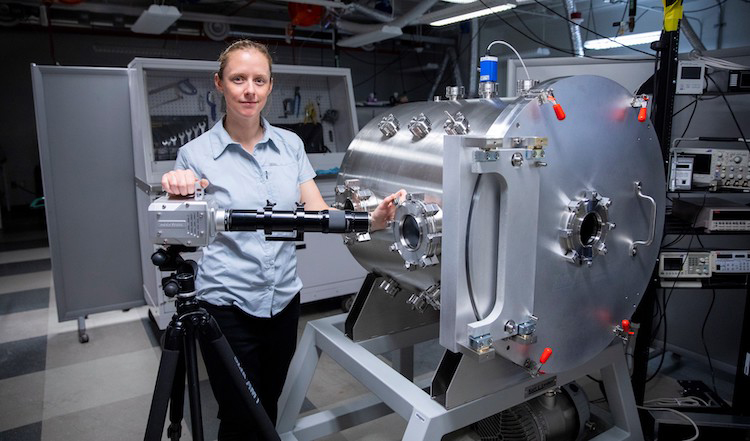UTEP professor of mechanical engineering, Amelia Greig, Ph.D., has been awarded the prestigious NASA Innovative Advanced Concepts (NIAC) grant to fund the development of lunar exploration and water extraction technologies.
NIAC is a research funding grant dedicated to developing significant concepts predicted to benefit NASA’s space exploration programs and every facet of its future research.
“A lot of research grants tend to focus on the immediate near-term, they want to see immediate results, whereas these grants are more for technologies that you might see in possibly 20 years’ time,” Greig said.
The central focus of Greig’s project is to effectively separate ionized water molecules from other elements and matter from unconsolidated superficial deposits on the surface of the moon known as a regolith. Decades of research by NASA and other universities confirmed in 2018, there is frozen water in the surface of the moon.
Unlike the Earth, which has ice sheets on top of the surface, the water on the moon is frozen into the rocks and soil, making it difficult to detect, Greig explained. The success of Greig’s project would in effect make the transportation of water from Earth unnecessary when commencing lunar exploration.
“Water is very heavy, and it’s difficult to get anything off the surface of the Earth. If we could find water there, we’d have to carry a lot less,” Greig said.
Greig explained the functionality of her project would increase the efficiency and amount of water capable of being collected from the moon’s surface. Rather than evaporating the water by heating it, a high voltage plasma arc would create a cloud full of ionized particles on the surface full of water, nickel, carbon, and other matter. These water molecules would be charged and therefore can be separated using electric and magnetic fields.
According to Greig, water is collected by putting the molecules through a magnetic field, which results in a curvature of their line of travel. While there will be multiple types of molecules in the cloud, a mass spectrometer will be able to determine the different masses and can therefore separate the water molecules alone by their mass. A reservoir is then placed where the field is directing the water movement and a much greater amount can be collected.
The UTEP lunar exploration program began about 18 months ago as part of the Center for Space Exploration Technology Research, referred to as the UTEP Aerospace Center, under the direction of Ahsan Choudhuri, Ph.D.
The program was a result of UTEP’s relationship with the NASA Johnson Space Center, which has continuously provided support for the program and its development. In collaboration with the Johnson Space Center, students and faculty at UTEP can create and expand the necessary technological advancements that can assist with sourcing and collecting the water from the moon’s surface.
Work on Greig’s project will begin in a few weeks after NASA releases the funding to the grant recipients, at which time Greig will be able to select two undergraduate and two graduate students for paid positions on the team.
According to Greig, there are three stages to the award.
Greig described the first phase as a “feasibility study,” essentially submitting the concept to NASA for them to determine if the project is promising in its beginning stages and can provide funding to further develop the idea over the course of nine months.
The second phase begins after this period, when Greig will submit another proposal with a more advanced rendering of the project for NASA to analyze. If it is determined the project will almost certainly work, further funding will be allocated for development and completion.
If the first two phases are successful and approved, the final third phase is the real-world implementation of the project.
Julian Herrera may be reached at [email protected].







